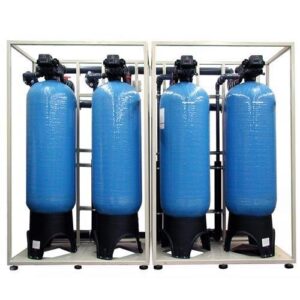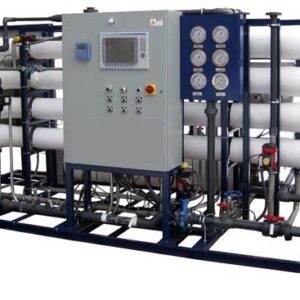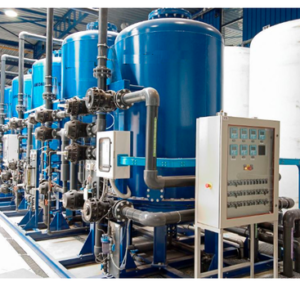Description
What is a water softening Plant?
Water Softener is a Water Filter that converts Hard Water into Soft Water through a process called the ion-exchange process. Hard water is water that has high mineral content. It contains dissolved compounds of calcium and magnesium.
Softeners are widely used for reducing hardness from water. Softening is a reversible ion exchange process wherein the hardness forming ions are exchanged with sodium ions present in the resin group.
Why it is important?
Feeding hard water in to boilers and chillers will deposit on its sufaces and thus form a slod layer on it called scale. Scale formation severly affect the performance of boilers by reducing heat transfer mechanism thus increase the fuel and maintenance cost. Therefore, to reduce the affect of hard water in the boilers and chillers, water should be softened before feeding into them. Softeners plays a major role in this process.
The Ion Exchange Process
Calcium (Ca2 +) and magnesium (Mg2 +) ions that cause water hardness can be removed fairly easily by using an ion exchange procedure. Standard water softeners are cation exchange devices. Cations refer to positively charged ions dissolved in the water. Cation exchange involves the replacement of the hardness ions with a nonhardness ion. Water softeners usually use sodium (Na+) as the exchange ion. Sodium ions are supplied from dissolved sodium chloride salt, also called brine. In the ion exchange process, sodium ions are used to coat an exchange medium in the softener. The exchange medium can be natural “zeolites” or synthetic resin beads that resemble wet sand. As hard water passes through a softener, the calcium and magnesium trade places with sodium ions. Sodium ions are held loosely and are replaced easily by calcium and magnesium ions. During this process, “free” sodium ions are released into the water.
Recharging Process
After softening a large quantity of hard water, the exchange medium becomes coated with calcium and magnesium ions. When this occurs, the exchange medium must be recharged or regenerated. To recharge the softener with sodium ions, a softener is backflushed with a salt brine solution. During a backflush, the brine solution replaces the calcium and magnesium ions on the exchange medium with sodium ions from the salt solution.
Operation and Maintenance
Maintenance of water softeners largely is confined to restocking the salt supply for the brine solution. With semiautomatic models, the owner also will have to start the recharging cycle. Salt can be purchased in the form of pellets, granules or blocks. The brine tank may require periodic cleaning. The frequency of cleaning depends on the amount and purity of the salt used in the softening process. The brine valve and float assembly also should be checked and cleaned as often as needed. The presence of excess iron or hydrogen sulfide can inhibit the effectiveness of a water-softening unit. Installation of the iron-removal equipment may be required. Water test results will help make that determination. More frequent backflushing (reversing the normal flow of water through the treatment unit) may be required to remove iron buildup.
Factors to Consider When Purchasing an Ion Exchange Water Softener
– Test your water to determine the hardness and other impurities that may need to be removed.
– Determine how much softened water you need per day, per year
– What type and size of softener will fit your situation?
– How easy is the softener to clean and/or repair?
– Will the dealer provide service?
– What type of convenience level should a softener offer (manual or automatic operation)?
– Will pretreatment be needed for iron and manganese?





